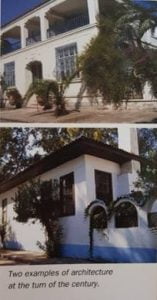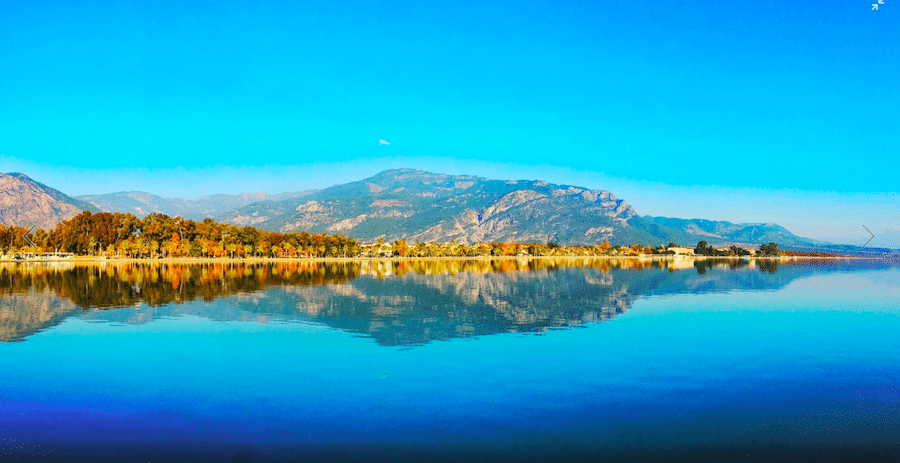”Koycegiz is a mill in the waterIts boundaries are at the water and the mountain”
Köyceğiz, from Township to District
The Köycegiz district, stretching at the side of the glittering green water of the Köycegiz Lake like an island of pack, is surrounded by the Mediterranean pack of the Western Taurus mountains to its north. The Olemez Mountain which is an extension of the Cankurtaran Mountain, the Kızlan mountain forming the last peaks of the Sandraz Mountains in the north and the Pandaluz Mountain to the northeast create a magnificent scene with these thick woodlands. The peak of the Çiçek Mountain 2,249 m), is the highest point of the Sandraz Mountain range and which remains covered in snow until midsummer, a spectacular enhancement to an already stunning view. Fed by import Yuvarlak, and Kargincık (Kargicak) Rivers, as well as the coldwater and thermal sources in its bed, the lake, which mirrors these majestic environs, unites its waters with the waves of thou Mediterranean through the Dalyan (Calbis) River that flows into the shade of the reeds. Ant rivers such as the Namnam, Countless springs from the interior Aegean lake region and the Taurus Mountains, fed the Dalyan River, the region’s largest which then flowed magnificently into the Mediterranean with all the It, sand and gravel it had been carrying for a millennia. This alluvial deposit settled into a wide bay and leaving the fertile soil of the Ortaca and Dalyan plains. The origin of the name Köyceğiz (small village), which to date has numerous buildings and a vast architectural heritage from the late 19th to early 20th centuries, is explained in a tragic legend: A long time ago, there was a large settlement on the area that is not covered by the lake. The area was completely inundated by a sudden rise in water and what remained was only a small number of houses. Those who witnessed the calamity said “the entire city was flooded, what remains is a small village” (Karaagaç-2006). The actual settlement of Köycegiz from the 13th to 18th centuries is unclear, however records indicate it was a town centre during the Menteseogullari and Ottoman periods The Ali Pasha farm that remains within the boundaries of the Köycegiz district today is shown as the town centre in the Province Charter of 1876. However, when entitlement to the farm was usurped and turned into an administrative centre, Ali Pasha sent numerous petitions to the government to object to the decree, finally his petitions were answered and the town centre was moved to Dalyan village. However, due to complaints stemming from Dalyan’s frequent flooding, inaccessibility during the winter months and its insignificant size, Mutasarnıf district governor Hilmi Pasha moved the town centre back to Köycegiz in 1879 location changed, was founded Yüksekkum within the Taki Aga farm, which forms the nucleus of the present town centre.

The oldest houses in Köycegiz were made by weaving thin chaste tree branches between posts driven in the ground with the interior walls covered in mud and roves topped with reed. Uncle Hüseyin’s house an example of this pastoral type of architectural, consisted of building materials obtained from the environs was unfortunately demolished in 2003. Stone buildings such as the Ali Pasha Mansion, the former land registration court and the notary building were all constructed by Greek master builder The traditional Köycegiz house structures using wooden trusses, employed timberwork of master builders from Ula who also constructed the Turkish houses in the same area. The splendid timber wood construction offered the flexibility required to endure the earthquakes along the fault lines found in this region. With the houses he constructed, Master Ivan, a Balkan immigrant, brought new wealth to Köycegiz’s architectural heritage. By the 18th century, the District of Köycegiz had earned a decent reputation for its sources and industry in sesame, grains, forestry and aquaculture as well as the honey and wax obtained through apiculture The Industrial Revolution that caused fundamental changes in the western world just began to show its affects here in the 19th century. While the large agricultural areas turned into cotton plantations citrus orchards became more widespread Lumbering, once the occupation of the Turkmen living in mountain villages, was taken over by the Bulgarians who were sought out to do this work and who were ultimately responsible for installing the first water-operated sawmills. Records from the province of Mugla mention 14 strong water-operated sawmills in the Köyceğiz forests between 1895-1896; from 1919-1911 they indicate that all kinds of timber and charcoal were obtained from 24 sawmill plants, which serves to document the speed of its development. With the 1839 Tanzimat (Reform) Charter, foreign nationals were granted the right to become partners in the mining companies incorporated by Ottoman nationals were given the right to “conduct mining solely or jointly provided that they abide within Ottoman law.” These efforts that subjects. With the Mines Act of November 18 1986, foreign aimed at attracting foreign capital in order to make use of nderground resources caused the rich chrome mines in the vicinity of Köycegiz to be operated by German and Swiss companies until the first years of the Republic.
between posts driven in the ground with the interior walls covered in mud and roves topped with reed. Uncle Hüseyin’s house an example of this pastoral type of architectural, consisted of building materials obtained from the environs was unfortunately demolished in 2003. Stone buildings such as the Ali Pasha Mansion, the former land registration court and the notary building were all constructed by Greek master builder The traditional Köycegiz house structures using wooden trusses, employed timberwork of master builders from Ula who also constructed the Turkish houses in the same area. The splendid timber wood construction offered the flexibility required to endure the earthquakes along the fault lines found in this region. With the houses he constructed, Master Ivan, a Balkan immigrant, brought new wealth to Köycegiz’s architectural heritage. By the 18th century, the District of Köycegiz had earned a decent reputation for its sources and industry in sesame, grains, forestry and aquaculture as well as the honey and wax obtained through apiculture The Industrial Revolution that caused fundamental changes in the western world just began to show its affects here in the 19th century. While the large agricultural areas turned into cotton plantations citrus orchards became more widespread Lumbering, once the occupation of the Turkmen living in mountain villages, was taken over by the Bulgarians who were sought out to do this work and who were ultimately responsible for installing the first water-operated sawmills. Records from the province of Mugla mention 14 strong water-operated sawmills in the Köyceğiz forests between 1895-1896; from 1919-1911 they indicate that all kinds of timber and charcoal were obtained from 24 sawmill plants, which serves to document the speed of its development. With the 1839 Tanzimat (Reform) Charter, foreign nationals were granted the right to become partners in the mining companies incorporated by Ottoman nationals were given the right to “conduct mining solely or jointly provided that they abide within Ottoman law.” These efforts that subjects. With the Mines Act of November 18 1986, foreign aimed at attracting foreign capital in order to make use of nderground resources caused the rich chrome mines in the vicinity of Köycegiz to be operated by German and Swiss companies until the first years of the Republic.

In the 1980s, when Ortaca was a newly developing settlement and Dalyan-Ortaca route was only a dirt road, the Köycegiz Lake and the Dalyan River were the most suitable means to reach ancient city of Caunos and the sea by using boats. With its teeming natural beauty tossled by cool mountain air blowing throughout the summer and its genial people, Köycegiz was an attractive tourism centre for domestic tourists and foreigners, who were not too many in those years. In Köycegiz, where I frequently came for short holidays with my family at the beginning of the 80s, was a great pleasure to have fish in the restaurant that was located set a long pier, that is no longer there, while watching. Although the couple of small hotels and hostels surrounding the town square in those days were far from comfortable, the hospitality made up for it. While under snow-capped mountains, you can still enjoy sailing around the lake. The opening of a wide highway connecting Mugla to Fethiye changed the balance of the region. Allied to the rapidly developing Ortaca district, Dalyan assumed leadership in the tourism of the region. However, the boundaries stretching from district surrounding Köycegiz lake moving east towards the ancient city of Caunos from the Dalyan river and onto the magnificent natural beach of the Ekincik Bay’s the pine-clad forests also contain dream-like nature and a rich cultural heritage. The healing waters and mud baths of Sultaniye’s hot springs, the Leto sanctuary founded during antiquity just behind the hot springs in honouring the mother of the twin deities Apollo and Artemis of Greek mythology, as well as the Roman thermal baths in the same location are all situated within the limits of Koycegiz. With the large and fully equipped camping site and the arrangements it has made along the coast, the Köycegiz Municipality is carrying out successful enterprises in order to increase the region’s tourism income. Many alternative tourism facilities such as nature walks water sports and spas are waiting to be actualised through the enterprises of the inhabitants of Koycegiz.



Comments